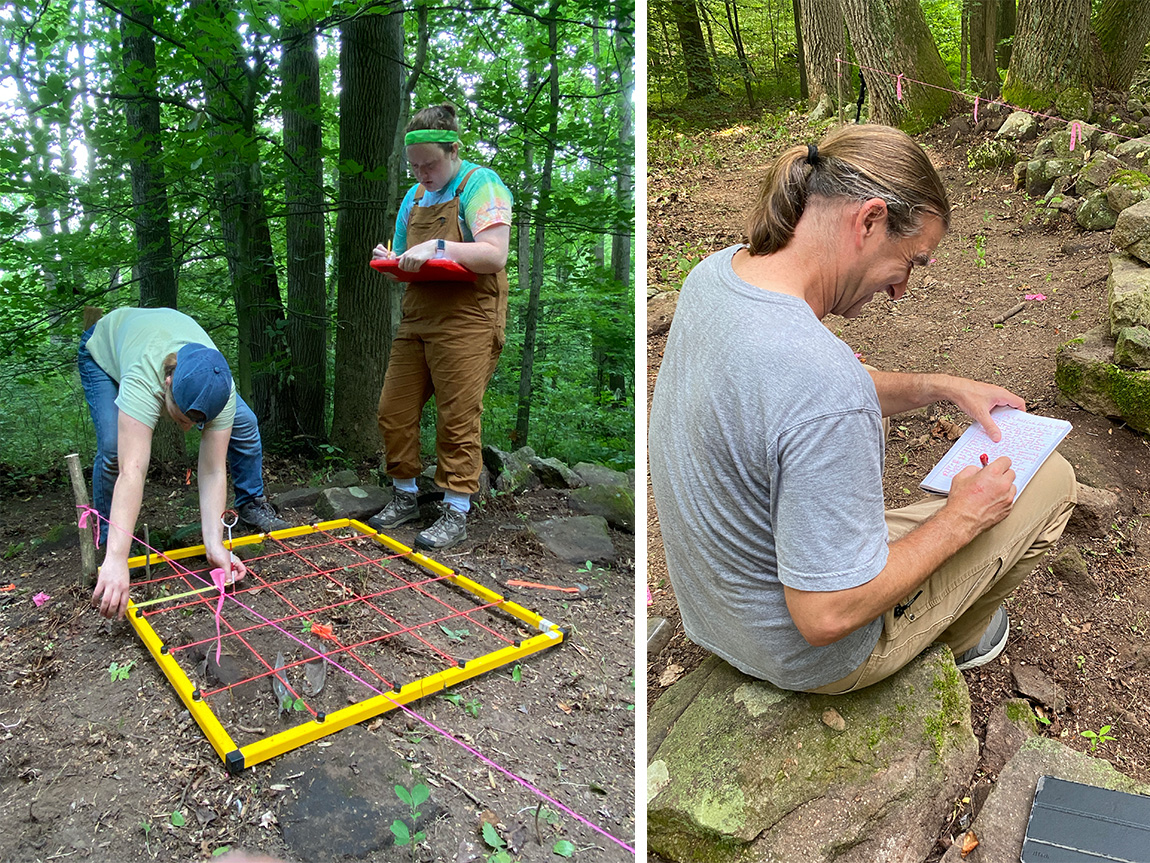Anthropology Research Examines Black Community Central to Underground Railroad
Associate Professor Ben Carter has worked with students and descendants to document portions of Six Penny Creek, a settlement home to about 50 people at its peak around 1870.By: Meghan Kita Monday, February 19, 2024 01:40 PM
 Michaela Zahner ’24, Emma Teske '25 and Associate Professor of Anthropology Ben Carter in the field last summer. Photos by Todd Lineburger
Michaela Zahner ’24, Emma Teske '25 and Associate Professor of Anthropology Ben Carter in the field last summer. Photos by Todd LineburgerIn French Creek State Park, about an hour from campus, lie remnants of Six Penny Creek, a small rural Black community that was central to the Underground Railroad. Associate Professor of Anthropology Ben Carter began learning about this community in 2020, when the pandemic forced his Field Archaeology class to drop most of its “field” components. Students were spread over multiple states, learning remotely. He hosted three optional field trips to French Creek State Park, which he chose because of its high density of charcoal hearths (structures once used to burn wood into charcoal) and its proximity to Hopewell Furnace National Historic Site (where students could see an iron furnace and try their hands at building a charcoal hearth).
As he was examining maps to prepare for the class, he found one that marked a “colored settlement” at Six Penny Creek among several pieces of property named for their white owners: “For many years, I’d noted a relationship between charcoal lands — vast tracts of thousands of acres of forests [used for producing charcoal during the 1800s] — and small rural Black settlements,” says Carter, who has been researching post-industrial charcoal lands since moving to the Lehigh Valley in 2004. “I kept not really knowing what to do with it. I don’t have a background in Black history. I didn’t know why they would be associated. The somewhat obvious erasure of individual names into just a ‘colored settlement’ made me feel like I had to stop just noticing this and do more.”

Michaela Zahner ’24 and Emma Teske '25 recording a home in Six Penny Creek last summer
In his preliminary research, he learned that descendents of some Six Penny Creek residents, the Cole family, own and continue to live on a parcel of land there. He mentioned this to his students in 2020 as he showed them around French Creek State Park but took a sabbatical the following spring to more thoroughly dive into the history of Six Penny Creek. He spent the time reading about Black history in Pennsylvania and learning more about the site.
Carter found that the peak of the community was around 1870, when almost 50 people were living there. The Coles’ land contains a garage that was once an African Methodist Episcopal (AME) church, established 1856, and he learned that AME churches were often stops on the Underground Railroad. He also found evidence that charcoal lands more broadly were part of that system, too: They’re massive areas of land that are hard for anyone unfamiliar with them to navigate, and they’re dotted with huts used by colliers — men who made charcoal — that could easily temporarily house people. This helped explain the many Black settlements near charcoal lands.
“Many of the people who lived [in Six Penny Creek] could have moved away. They could have moved on to Canada. They stayed because they wanted to help others.”
—Associate Professor of Anthropology Ben Carter
The next step was to get in touch with the Cole family, which Carter did in mid-2021. Since then, he and students have been working in French Creek State Park to continue to survey the settlement. In Field Archaeology in Fall 2022, Michaela Zahner ’24 discovered the foundation to a home that belonged to a Black man named Levi DeHart; last summer, Carter, Zahner and Emma Teske '25 worked to record his home in greater detail. They plan to share their work with the Coles soon.
“It’s not my history, and to be honest, white academics have not treated Black history very well,” Carter says. “We’ll get [the Cole family’s] feedback on what they think should happen next. They are in the driver’s seat.”

Carter at the site of Levi DeHart’s home last summer
Carter says students are often surprised to learn about Six Penny Creek and communities like it: American history tends to overlook the experiences of Black people in the north during the Civil War era, especially of those living outside cities, and the story of the Underground Railroad is often focused on white abolitionists.
“Many of the people who lived [in Six Penny Creek] could have moved away. They could have moved on to Canada. They stayed because they wanted to help others … The story is not often about how Black communities supported each other,” Carter says. “Black history is all around us. If you look, it’s there, and we need to do more looking.”
Learn more about Carter’s work from this article he wrote for the Pennsylvania Parks & Forests Foundation, and read his “Statement on Working on Black History” here.
